Regional Distribution and Causes of Global Mine Tailings Dam Failures
Abstract
1. Introduction
2. Causal Analysis of Tailings Pond Dam Failures
2.1. Statistics of Tailings Pond Dam Failures
- Very serious tailings dam failures: multiple loss of life (>20) and/or release of 1,000,000 m3 totals discharge, and/or release travel distance of 20 km or more.
- Serious tailings dam failures: loss of life and/or release of ≥100,000 m3 semi-solids.
- Other tailings dam failures: engineering/facility failures other than those classified as very serious or serious, no loss of life.
- Other tailings-related accidents: accidents are other than those classified as type 1, 2, or 3.
- Structure and condition of the dam foundation (FN)
- Earthquakes (EQ)
- Mine subsidence (MS)
- Structural inadequacies, inadequate or failed decants (ST)
- External erosion (ER)
- Seepage and internal erosion (SE)
- Overtopping (OT)
- Slope instability (SI)
2.2. Analysis of Tailings Pond Dam Failures
3. Regional Analysis of Tailings Pond Dam Failure Accidents
4. Conclusions
- We found that the average frequency of tailings pond accidents from 1947 to 2021 was 4.4 per year, and the frequency of tailings pond failures in Asia and the Americas, especially in China (n = 43) and the United States (n = 107), was significantly higher than in other regions. With the increase of large and high tailings ponds, the number of very serious tailings pond accidents is also increasing.
- The causes of 258 failures were identified, while those of 84 failures remain unknown. Among the 258 tailings pond failures with known causes, 10.1% were caused by ST (26), 22.1% by SI (57), 17.1% by EQ (44), 5% by ER (13), 11.2% by SE (29), more than 24.4% by OT (63), 0.4% by MS (1), and 9.7% by FN (25). Most tailings pond failures were directly related to heavy rainfall or earthquakes. Since much of the information regarding tailings pond failures is not disclosed or was undetected, we need to build a better database to capture and document this information.
- Economic development cannot be achieved without the exploitation of mineral resources. We found that the increase in the number of tailings dam failures in developing countries is closely associated with damming methods, climate and earthquakes. The US method is used by most developing countries due to the low construction difficulty and low cost, but tailings dams constructed with the US method have the highest risk of failure. Developing countries need to improve their tailings pond construction, maintenance and monitoring capabilities.
Author Contributions
Funding
Institutional Review Board Statement
Informed Consent Statement
Data Availability Statement
Conflicts of Interest
References
- Venter, O.; Sanderson, E.W.; Magrach, A.; Allan, J.R.; Beher, J.; Jones, K.R.; Possingham, H.P.; Laurance, W.F.; Wood, P.; Fekete, B.M.; et al. Sixteen years of change in the global terrestrial human footprint and implications for biodiversity conservation. Nat. Commun. 2016, 7, 12558. [Google Scholar] [CrossRef] [PubMed]
- Wang, G.J.; Tian, S.; Hu, B.; Kong, X.Y.; Chen, J. An experimental study on tailings deposition characteristics and variation of tailings dam saturation line. Geomech. Eng. 2020, 23, 85–92. [Google Scholar]
- Edraki, M.; Baumgartl, T.; Manlapig, E.; Bradshaw, D.; Franks, D.M.; Moran, C.J. Designing mine tailings for better environmental, social and economic outcomes: A review of alternative approaches. J. Clean. Prod. 2014, 84, 411–420. [Google Scholar] [CrossRef]
- Adiansyah, J.S.; Rosano, M.; Vink, S.; Keir, G. A framework for a sustainable approach to mine tailings management: Disposal strategies. J. Clean. Prod. 2015, 108, 1050–1062. [Google Scholar] [CrossRef]
- Wang, S.; Mei, G.; Xie, X.; Guo, L. The Influence of the Instantaneous Collapse of Tailings Pond on Downstream Facilities. Adv. Civ. Eng. 2021, 2021, 4253315. [Google Scholar] [CrossRef]
- Clarkson, L.; Williams, D. Critical review of tailings dam monitoring best practice. Int. J. Min. Reclam. Environ. 2020, 34, 119–148. [Google Scholar] [CrossRef]
- Mei, G.D.; Wu, Z.Z. Research on the dam-break hazard vulnerability assessment index system and methods of tailings pond. In Applied Mechanics and Materials; Trans Tech Publications Ltd.: Freinbach, Switzerland, 2012; Volume 204, pp. 3450–3456. [Google Scholar] [CrossRef]
- Kheirkhah Gildeh, H.; Halliday, A.; Arenas, A.; Zhang, H. Tailings dam breach analysis: A review of methods, practices, and uncertainties. Mine Water Environ. 2021, 40, 128–150. [Google Scholar] [CrossRef]
- Kossoff, D.; Dubbin, W.E.; Alfredsson, M.; Edwards, S.J.; Macklin, M.G.; Hudson-Edwards, K.A. Mine tailings dams: Characteristics, failure, environmental impacts, and remediation. Appl. Geochem. 2014, 51, 229–245. [Google Scholar] [CrossRef]
- Lv, S.R. Discussion on stability analysis method for tailings dam. Appl. Mech. Mater. 2012, 204, 93–96. [Google Scholar] [CrossRef]
- Burritt, R.L.; Christ, K.L. Full cost accounting: A missing consideration in global tailings dam management. J. Clean. Prod. 2021, 321, 129016. [Google Scholar] [CrossRef]
- Hudson-Edwards, K.A.; Macklin, M.G.; Miller, J.R.; Lechler, P.J. Sources, distribution and storage of heavy metals in the Rıo Pilcomayo, Bolivia. J. Geochem. Explor. 2001, 72, 229–250. [Google Scholar] [CrossRef]
- Chryss, A.; Fourie, A.B.; Monch, A.; Nairn, D.; Seddon, K.D. Towards an integrated approach to tailings management. J. South. Afr. Inst. Min. Metall. 2012, 112, 965–969. [Google Scholar] [CrossRef]
- Caldwell, J.A.; Oboni, F.; Oboni, C. Tailings facility failures in 2014 and an update on failure statistics. In Tailings and Mine Waste; University of British Columbia: Kelowna, BC, Canada, 2015; pp. 25–28. [Google Scholar] [CrossRef]
- Sovacool, B.K.; Ali, S.H.; Bazilian, M.; Radley, B.; Nemery, B.; Okatz, J.; Mulvaney, D. Sustainable minerals and metals for a low-carbon future. Science 2020, 367, 30–33. [Google Scholar] [CrossRef] [PubMed]
- Islam, K.; Vilaysouk, X.; Murakami, S. Integrating remote sensing and life cycle assessment to quantify the environmental impacts of copper-silver-gold mining: A case study from Laos. Resour. Conserv. Recycl. 2020, 154, 104630. [Google Scholar] [CrossRef]
- Glotov, V.E.; Chlachula, J.; Glotova, L.P.; Little, E. Causes and environmental impact of the gold-tailings dam failure at Karamken, the Russian Far East. Eng. Geol. 2018, 245, 236–247. [Google Scholar] [CrossRef]
- Azam, S.; Li, Q. Tailings dam failures: A review of the last one hundred years. Geotech. News 2010, 28, 50–54. [Google Scholar]
- Rana, N.M.; Ghahramani, N.; Evans, S.G.; McDougall, S.; Small, A.; Take, W.A. Catastrophic mass flows resulting from tailings impoundment failures. Eng. Geol. 2021, 292, 106262. [Google Scholar] [CrossRef]
- Bowker, L.N.; Chambers, D.M. In the dark shadow of the supercycle tailings failure risk & public liability reach all time highs. Environments 2017, 4, 75. [Google Scholar] [CrossRef]
- Wang, G.; Tian, S.; Hu, B.; Xu, Z.; Chen, J.; Kong, X. Evolution pattern of tailings flow from dam failure and the buffering effect of debris blocking dams. Water 2019, 11, 2388. [Google Scholar] [CrossRef]
- de Paiva, C.A.; da Fonseca Santiago, A.; do Prado Filho, J.F. Content analysis of dam break studies for tailings dams with high damage potential in the Quadrilátero Ferrífero, Minas Gerais: Technical weaknesses and proposals for improvements. Nat. Hazards 2020, 104, 1141–1156. [Google Scholar] [CrossRef]
- Rico, M.; Benito, G.; Salgueiro, A.R.; Díez-Herrero, A.; Pereira, H.G. Reported tailings dam failures: A review of the European incidents in the worldwide context. J. Hazard. Mater. 2008, 152, 846–852. [Google Scholar] [CrossRef] [PubMed]
- Cuervo, V.; Burge, L.; Beaugrand, H.; Hendershot, M.; Evans, S.G. Downstream geomorphic response of the 2014 Mount Polley tailings dam failure, British columbia. In Workshop on World Landslide Forum; Springer: Berlin/Heidelberg, Germany, 2017; pp. 281–289. [Google Scholar] [CrossRef]
- Vanden Berghe, J.F.; Ballard, J.C.; Pirson, M.; Reh, U. Risks of Tailings Dams Failure. In Proceedings of the 3rd International Symposium on Geotechnical Safety and Risk, ISGSR, Munich, Germany, 2–3 June 2011; pp. 209–216. [Google Scholar]
- Thompson, F.; de Oliveira, B.C.; Cordeiro, M.C.; Masi, B.P.; Rangel, T.P.; Paz, P.; Freitas, T.; Lopes, G.; Silva, B.S.; Cabral, A.S.; et al. Severe impacts of the Brumadinho dam failure (Minas Gerais, Brazil) on the water quality of the Paraopeba River. Sci. Total Environ. 2020, 705, 135914. [Google Scholar] [CrossRef] [PubMed]
- Liu, S.; Chai, B.; Du, J.; Luo, F.; Xiao, L. Risk post-assessment and management of a waste slag site under extreme scenarios. Bull. Eng. Geol. Environ. 2020, 79, 2659–2677. [Google Scholar] [CrossRef]
- Zheng, X.; Xu, X.H.; Xu, K.L. Study on the risk assessment of the tailings dam break. Procedia Eng. 2011, 26, 2261–2269. [Google Scholar] [CrossRef]
- Quaresma, V.S.; Bastos, A.C.; Leite, M.D.; Costa Jr, A.; Cagnin, R.C.; Grilo, C.F.; Zogheib, L.F.; Oliveira, K.S.S. The effects of a tailing dam failure on the sedimentation of the eastern Brazilian inner shelf. Cont. Shelf Res. 2020, 205, 104172. [Google Scholar] [CrossRef]
- Wang, K.; Yang, P.; Hudson-Edwards, K.; Lu, W.S.; Bu, L. Status and development for the prevention and management of tailings dam failure accidents. Chin. J. Eng. 2018, 40, 526–539. [Google Scholar] [CrossRef]
- Zobrist, J.; Giger, W. Mining and the environment. Environ. Sci. Pollut. Res. 2013, 20, 7487–7489. [Google Scholar] [CrossRef][Green Version]
- Liang, L.; Liu, Q.; Li, M. Dam-break risk assessment model of tailings reservoir based on variable weight synthesis and analytic hierarchy process. J. Northeast. Univ. (Nat. Sci.) 2017, 38, 1790. [Google Scholar] [CrossRef]
- Ishihara, K.; Ueno, K.; Yamada, S.; Yasuda, S.; Yoneoka, T. Breach of a tailings dam in the 2011 earthquake in Japan. Soil Dyn. Earthq. Eng. 2015, 68, 3–22. [Google Scholar] [CrossRef]
- Cleary, P.W.; Prakash, M.; Mead, S.; Tang, X.; Wang, H.; Ouyang, S. Dynamic simulation of dam-break scenarios for risk analysis and disaster management. Int. J. Image Data Fusion 2012, 3, 333–363. [Google Scholar] [CrossRef]
- Armstrong, M.; Petter, R.; Petter, C. Why have so many tailings dams failed in recent years? Resour. Policy 2019, 63, 101412. [Google Scholar] [CrossRef]
- Rotta, L.H.S.; Alcantara, E.; Park, E.; Negri, R.G.; Lin, Y.N.; Bernardo, N.; Mendes, T.S.G.; Souza Filho, C.R. The 2019 Brumadinho tailings dam collapse: Possible cause and impacts of the worst human and environmental disaster in Brazil. Int. J. Appl. Earth Obs. Geoinf. 2020, 90, 102119. [Google Scholar] [CrossRef]
- Lumbroso, D.; Collell, M.R.; Petkovsek, G.; Davison, M.; Liu, Y.; Goff, C.; Wetton, M. DAMSAT: An eye in the sky for monitoring tailings dams. Mine Water Environ. 2021, 40, 113–127. [Google Scholar] [CrossRef]
- Villavicencio, G.; Espinace, R.; Palma, J.; Fourie, A.; Valenzuela, P. Failures of sand tailings dams in a highly seismic country. Can. Geotech. J. 2014, 51, 449–464. [Google Scholar] [CrossRef]
- Shen, L.; Luo, S.; Zeng, X.; Wang, H. Review on anti-seepage technology development of tailings pond in China. Procedia Eng. 2011, 26, 1803–1809. [Google Scholar] [CrossRef]
- Wu, Z.Z.; Mei, G.D. Statistical analysis of tailings pond accidents and cause analysis of dam failure. J. Saf. Sci. Technol. 2014, 24, 70–76. [Google Scholar] [CrossRef]
- Zardari, M.A.; Mattsson, H.; Knutsson, S.; Khalid, M.S.; Ask, M.V.; Lund, B. Numerical analyses of earthquake induced liquefaction and deformation behaviour of an upstream tailings dam. Adv. Mater. Sci. Eng. 2017, 1–12. [Google Scholar] [CrossRef]
- Teramoto, E.H.; Gemeiner, H.; Zanatta, M.B.; Menegário, A.A.; Chang, H.K. Metal speciation of the Paraopeba river after the Brumadinho dam failure. Sci. Total Environ. 2021, 757, 143917. [Google Scholar] [CrossRef]
- Islam, K.; Murakami, S. Global-scale impact analysis of mine tailings dam failures: 1915–2020. Glob. Environ. Chang. 2021, 70, 102361. [Google Scholar] [CrossRef]
- Dutto, P.; Stickle, M.M.; Pastor, M.; Manzanal, D.; Yague, A.; Tayyebi, S.M.; Lin, C.; Elizalde, M.D. Modelling of Fluidized Geomaterials: The Case of the Aberfan and the Gypsum Tailings Impoundment Flowslides. Materials 2017, 10, 562. [Google Scholar] [CrossRef]
- Laouafa, F.; Darve, F. Modelling of slope failure by a material instability mechanism. Comput. Geotech. 2002, 29, 301–325. [Google Scholar] [CrossRef]
- Ledesma, O.; Sfriso, A.; Manzanal, D. Procedure for assessing the liquefaction vulnerability of tailings dams. Comput. Geotech. 2022, 144, 104632. [Google Scholar] [CrossRef]
- Chen, C.C.; Zhao, Y.Q.; Jiang, L.J. Review on research of dam break of tailings pond. Min. Res. Dev. 2019, 39, 103–108. [Google Scholar]
- Wang, W.; Yin, G.; Wei, Z.; Zhang, Q.; Jin, X. Study of the dynamic stability of tailings dam based on time-history analysis method. J. China Univ. Min. Technol. 2018, 47, 271–279. [Google Scholar] [CrossRef]
- Bonelli, S. (Ed.) Erosion of Geomaterials; John Wiley & Sons: Hoboken, NJ, USA, 2012. [Google Scholar] [CrossRef]
- Coulibaly, Y.; Belem, T.; Cheng, L. Numerical analysis and geophysical monitoring for stability assessment of the Northwest tailings dam at Westwood Mine. Int. J. Min. Sci. Technol. 2017, 27, 701–710. [Google Scholar] [CrossRef]
- Silva, V.; Amo-Oduro, D.; Calderon, A.; Dabbeek, J.; Despotaki, V.; Martins, L.; Rao, A.; Simionato, M.; Viganò, D.; Yepes-Estrada, C.; et al. Global Earthquake Model (GEM) Seismic Risk Map (Version 2018.1); GEM Foundation: Pavia, Italy, 2018. [Google Scholar] [CrossRef]
- Song, Z.P.; Yin, J.Y.; Xue, Y.; Zhang, G.M.; Liu, J.; Zhu, Y.Q.; Zhang, Y.X. The global and sub-zone period characteristics for large earthquakes. Chin. J. Geophys. 2013, 56, 1868–1876. [Google Scholar] [CrossRef]
- Kossobokov, V.G.; Nekrasova, A.K. Global seismic hazard assessment program maps are erroneous. Seism. Instrum. 2012, 48, 162–170. [Google Scholar] [CrossRef]
- Rastogi, B.K.; Sharma, J. Global seismic temporal pattern and enhanced seismicity since 2000. J. Ind. Geophys 2016, 20, 316–324. [Google Scholar]
- Liang, G.H. Distribution of seismic zones in China. Encycl. Knowl. 2016, 14, 1–2. [Google Scholar]
- Du, G.; Wu, Q.; Zhang, X.; He, J.; Zou, L.; Feng, Y.; Liu, J.; Romanelli, F. Pn wave velocity and anisotropy underneath the central segment of the North-South Seismic Belt in China. J. Asian Earth Sci. 2019, 184, 103941. [Google Scholar] [CrossRef]
- You, T.; Wu, R.; Liu, G.; Chai, Z. Contribution of precipitation events with different consecutive days to summer rainfall change over China. Theor. Appl. Climatol. 2020, 141, 1493–1510. [Google Scholar] [CrossRef]
- Wang, Z.Y.; Ding, Y.H. Climatic characteristics of rainy season in China. Chin. J. Atmos. Sci. 2008, 32, 1–13. [Google Scholar] [CrossRef]
- Lu, P.; Zhang, H.; Gao, L.; Comte, D. Seismic imaging of the double seismic zone in the subducting slab in Northern Chile. Earthq. Res. Adv. 2021, 1, 100003. [Google Scholar] [CrossRef]
- Celle-Jeanton, H.; Travi, Y.; Blavoux, B. Isotopic typology of the precipitation in the Western Mediterranean region at three different time scales. Geophys. Res. Lett. 2001, 28, 1215–1218. [Google Scholar] [CrossRef]
- Zhong, J.; Li, S.L.; Ibarra, D.E.; Ding, H.; Liu, C.Q. Solute production and transport processes in Chinese monsoonal rivers: Implications for global climate change. Glob. Biogeochem. Cycles 2020, 34, e2020GB006541. [Google Scholar] [CrossRef]
- Kong, F.; Wang, Y.F.; Lv, L.L. Spatial and temporal variations in global, continental and regional scale rainfall over the past 100 years (1900–2010). J. Catastrophology 2018, 33, 81–88+95. [Google Scholar]
- Clarkson, L.; Williams, D. An overview of conventional tailings dam geotechnical failure mechanisms. Min. Metall. Explor. 2021, 38, 1305–1328. [Google Scholar] [CrossRef]
- Omachi, C.Y.; Siani, S.M.; Chagas, F.M.; Mascagni, M.L.; Cordeiro, M.; Garcia, G.D.; Thompson, C.C.; Siegle, E.; Thompson, F.L. Atlantic Forest loss caused by the world’ s largest tailing dam collapse (Fundão Dam, Mariana, Brazil). Remote Sens. Appl. Soc. Environ. 2018, 12, 30–34. [Google Scholar] [CrossRef]



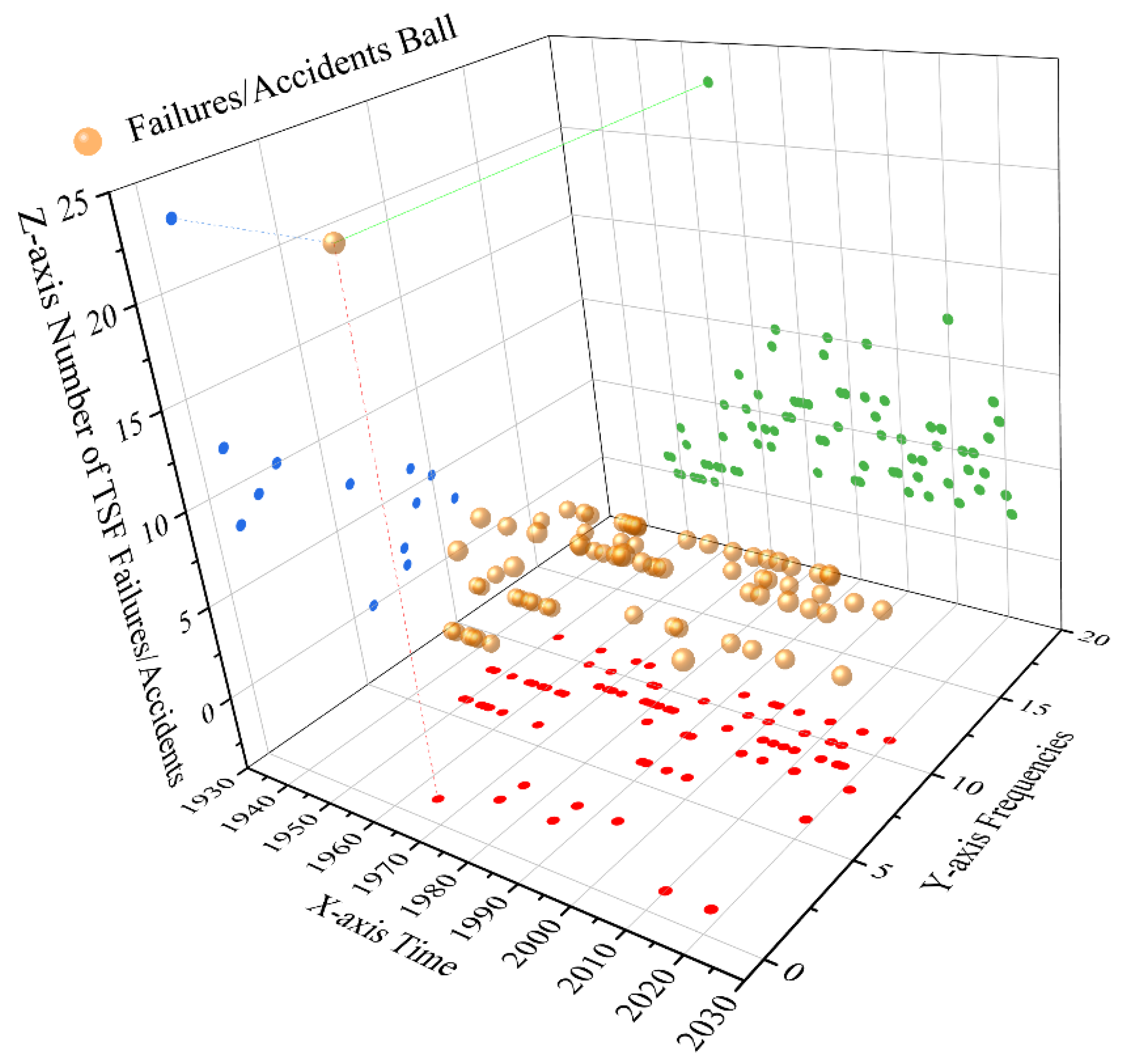
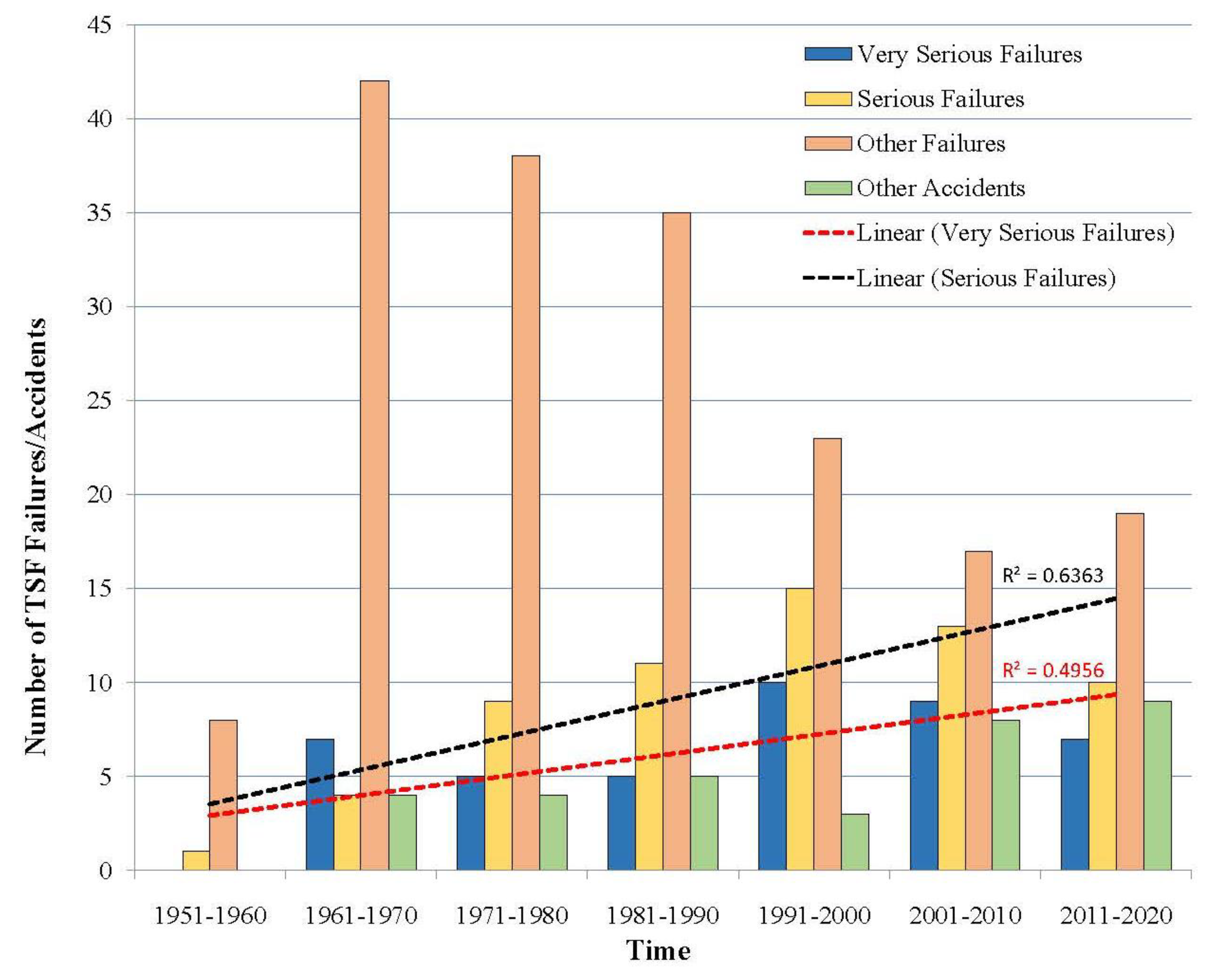
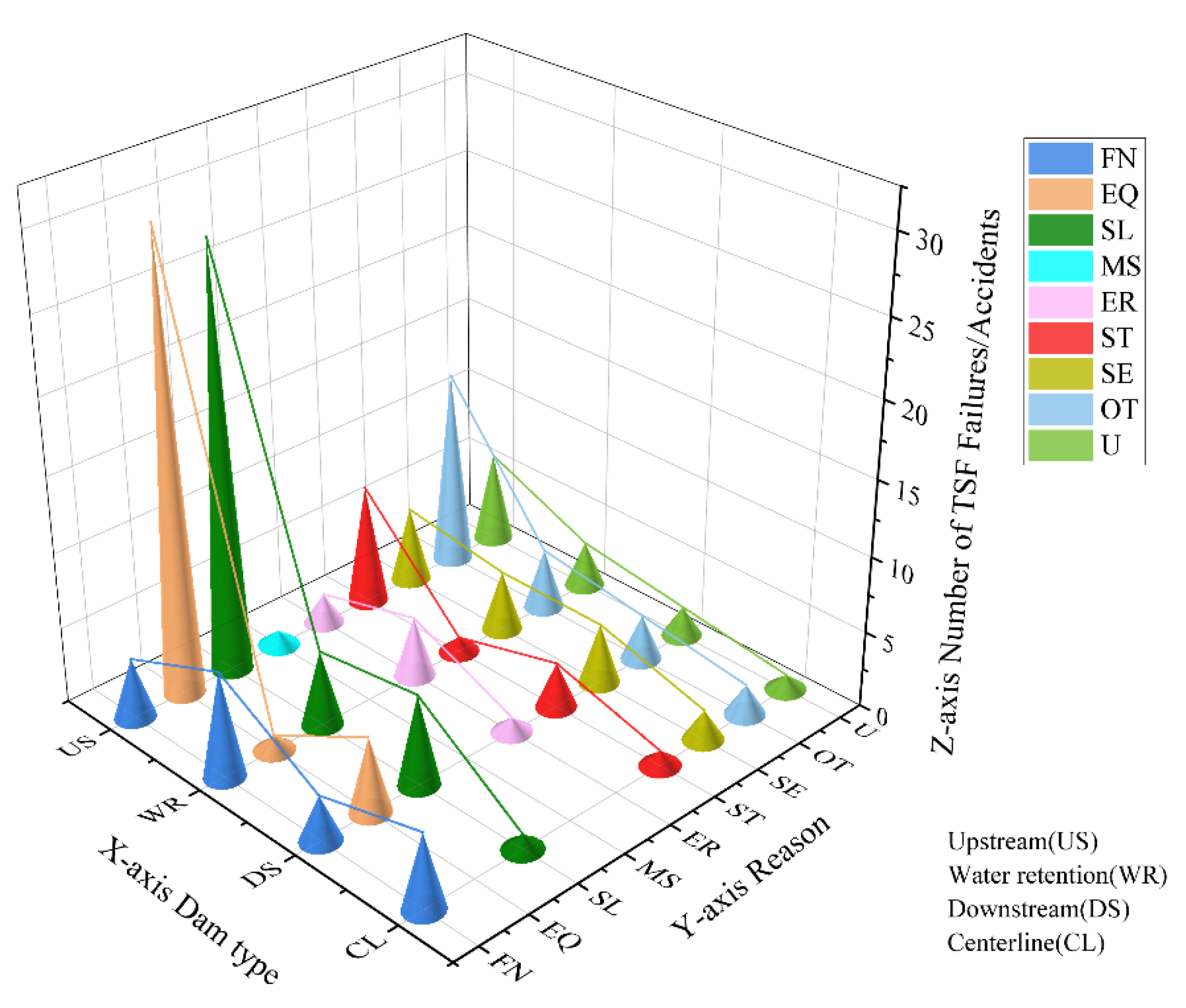

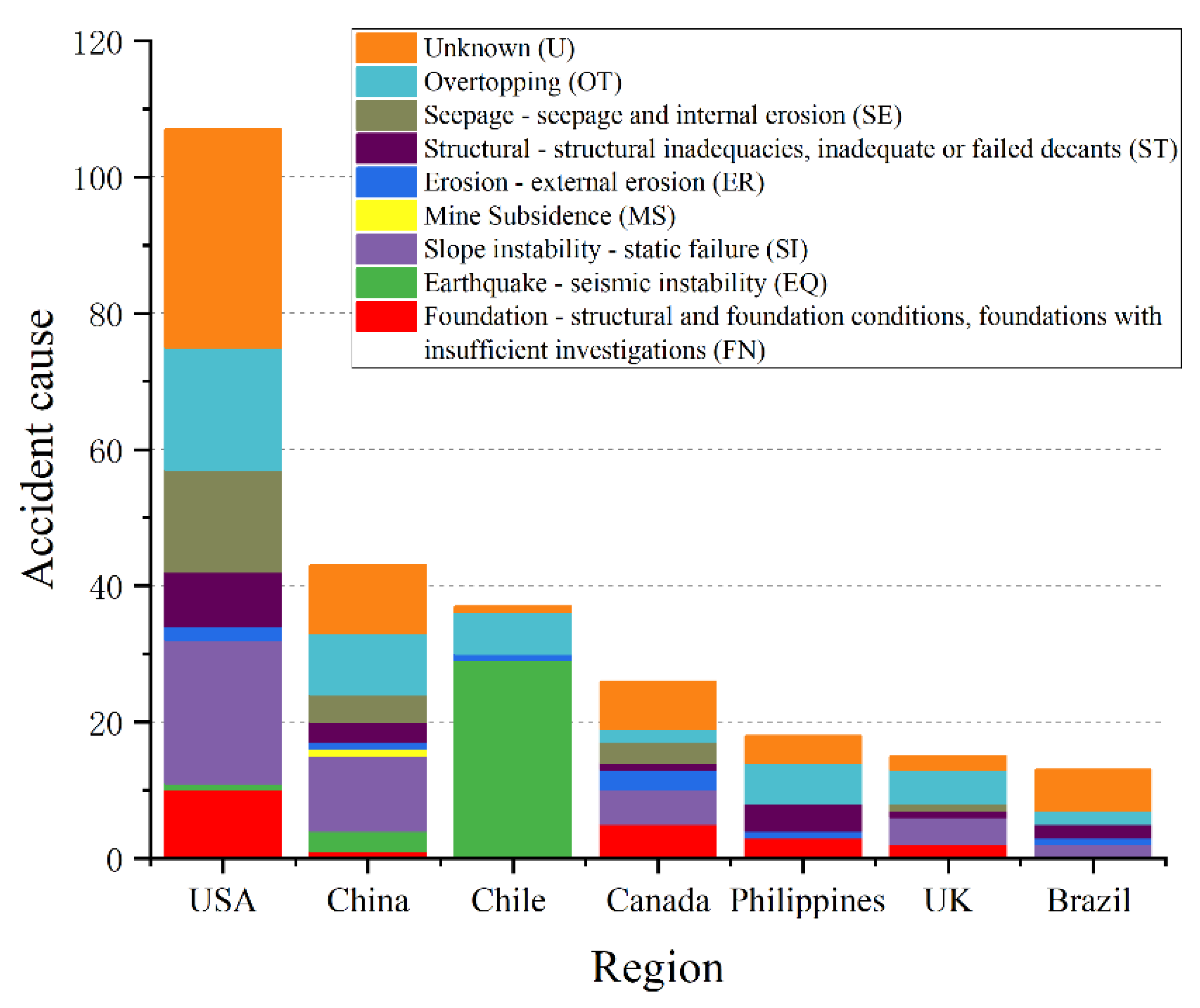





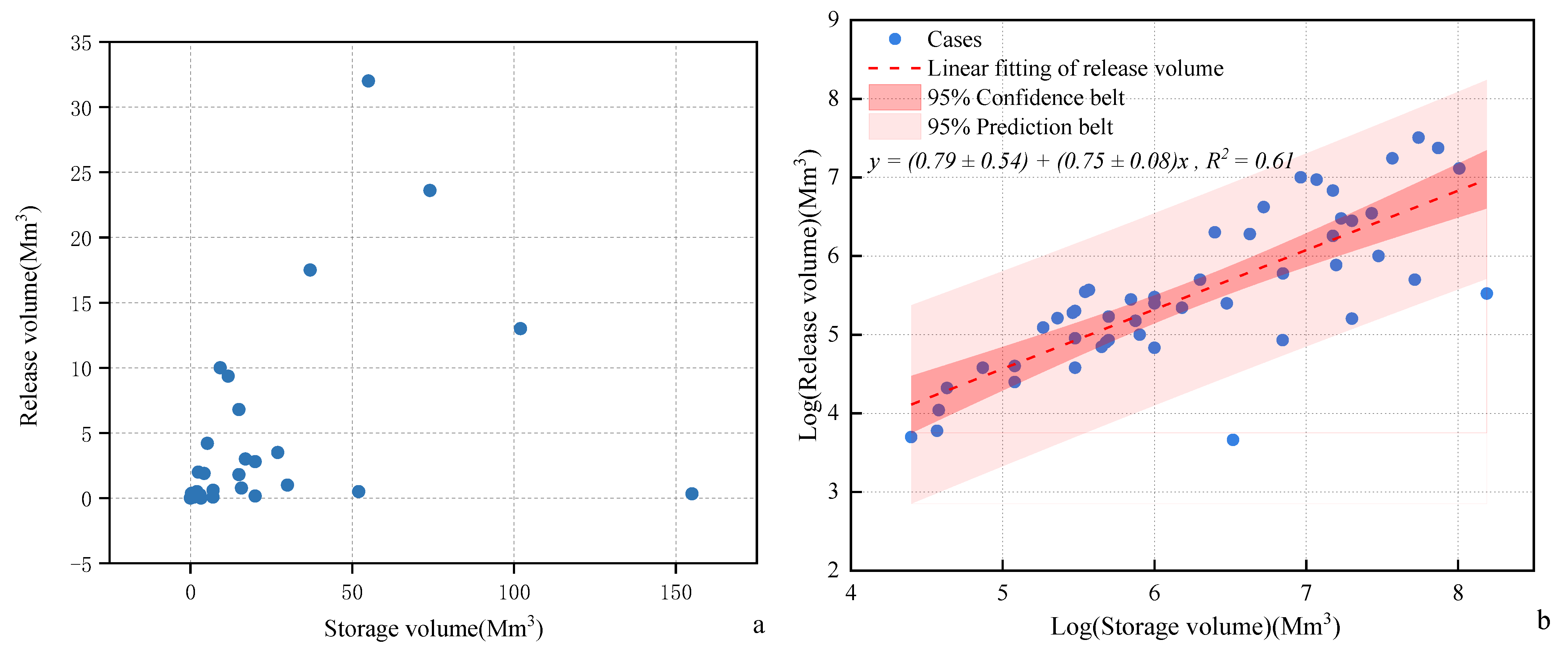


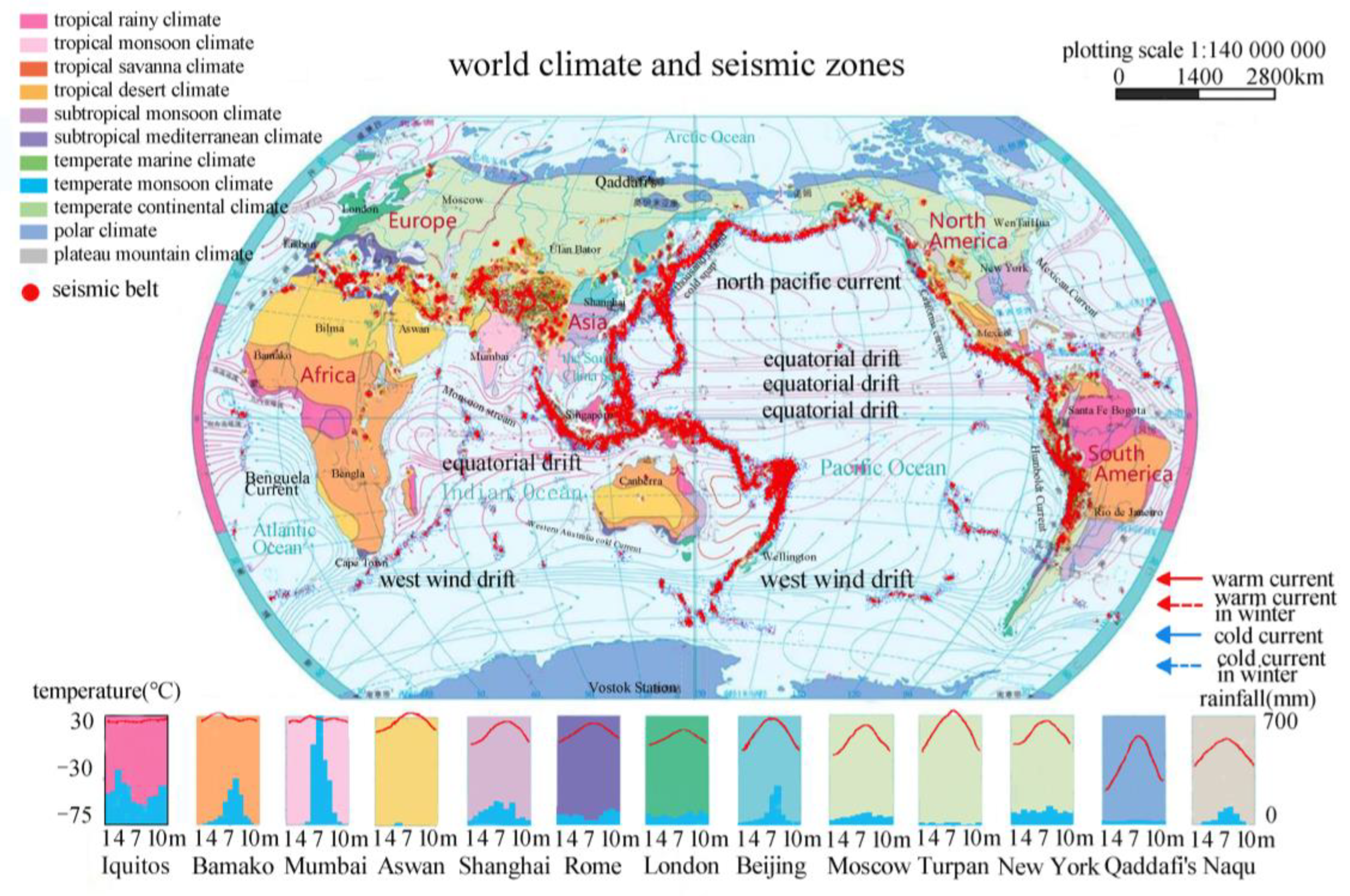
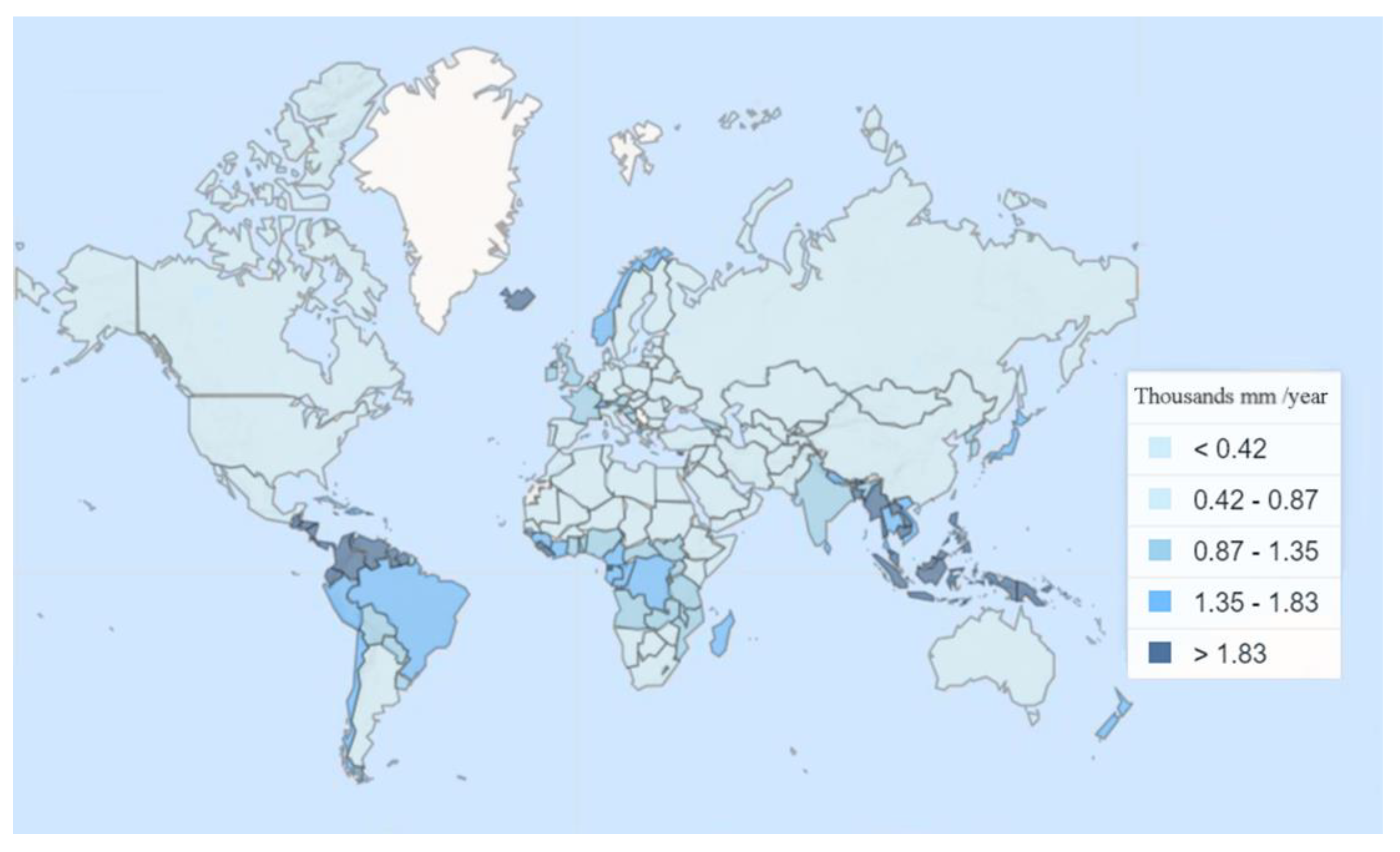
| Reason | Number of Accidents | Region |
|---|---|---|
| SI | n = 57 (22.1%) | n = 1 (Bulgaria, Italy, Ukraine, Russia, Yugoslavia, Romania, Zambia, Spain, Australia, South Africa); n = 2 (Brazil); n = 3 (South Africa); n = 4 (UK); n = 5 (Canada); n = 11 (China); n = 21 (USA) |
| MS | n = 1 (0.4%) | n = 1 (China) |
| SE | n = 29 (11.2%) | n = 1 (Finland, Hungary, Peru, South Africa, France, UK, Australia); n = 3 (Canada); n = 4 (China); n = 15 (USA) |
| ST | n = 26 (10.1%) | n = 1 (UK, Ecuador, India, Canada, Macedonia, Romania, Hungary, Bulgaria Mexico); n = 2 (Brazil); n = 3 (China, Philippines); n = 8 (USA) |
| FN | n = 25 (9.7%) | n = 1 (China, Australia, New Zealand, Russia, Spain, China); n = 2 (UK); n = 3 (Philippines); n = 5 (Canada); n = 10 (USA) |
| OT | n = 63 (24.4%) | n = 1 (Zambia, Portugal, Peru, Zimbabwe, South Africa, Spain, Brazil); n = 2 (Mexico, Canada); n = 3 (Australia); n = 5 (UK); n = 6 (Chile, Philippines); n = 10 (China); n = 14 (USA); n = 1 (Region unknown) |
| EQ | n = 44 (17.1%) | n = 1 (USA); n = 2 (Peru Argentina); n = 3 (China); n = 5 (Japan); n = 29 (Chile) |
| ER | 13 (5%) | n = 1 (Philippines, China, Chile, Sweden, Guyana, Montenegro, Bulgaria, Brazil); n = 2(Canada, USA). |
| Region | Number | Causes of Dam Failure | ||
|---|---|---|---|---|
| Oceania | New Zealand | 1 | 1 FN | 9 (3 OT, 1 ER, 1 SI, 2 Unknown, 2 FN) |
| Australia | 8 | 3 OT, 1 ER, 1 SI, 2 Unknown, 1 FN | ||
| Asia | Turkey | 1 | Unknown | 73 (4 FN, 8 EQ, 12 SI, 1 MS, 2 ER, 8 ST, 4 SE, 15 OT, 19 Unknown) |
| Israel | 1 | SI | ||
| India | 2 | 1 ST, 1 Unknown | ||
| Myanmar | 3 | 3 Unknown | ||
| Japan | 5 | 5 EQ | ||
| Philippines | 18 | 6 OT, 4 ST, 3 FN,1 ER, 4 Unknown | ||
| China | 43 | 1 FN, 3 EQ, 11 SI, 1 MS, 1 ER, 3 ST, 4 SE, 9 OT, 10 Unknown | ||
| Europe | Finland | 1 | SE | 43 (7 OT,4 SE,5 ST,12 SI,4 FN,3 ER, 8 Unknown) |
| Portugal | 1 | OT | ||
| Swedish | 1 | ER | ||
| Montenegro | 1 | ER | ||
| Italy | 1 | SI | ||
| Ukraine | 1 | SI | ||
| Yugoslavia | 1 | SI | ||
| Belgium | 1 | Unknown | ||
| Macedonia | 1 | ST | ||
| French | 2 | 1 SE, 1 Unknown | ||
| Hungary | 2 | 1 SE, 1 ST | ||
| Romania | 3 | 1 ST, 1 SI, 1 Unknown | ||
| Spain | 3 | 1 OT, 1 FN, 1 SI | ||
| Bulgaria | 4 | 2 SI, 1 ER, 1 ST | ||
| Russia | 5 | 1 SI, 1 FN, 3 Unknown | ||
| UK | 15 | 5 OT, 1 SE, 1 ST, 4 SI, 2 FN, 2 Unknown | ||
| Africa | Armenia | 1 | OT | 16 (4 SI, 1 SE, 4 OT, 1 ST, 6 Unknown) |
| Ghana | 1 | Unknown | ||
| Zimbabwe | 1 | OT | ||
| Angola | 1 | Unknown | ||
| Liberia | 1 | ST | ||
| Namibia | 1 | Unknown | ||
| Zambia | 3 | 1 OT, 1 SI, 1 Unknown | ||
| South Africa | 7 | 3 SI, 1 SE, 1 OT, 2 Unknown | ||
| America | Guyana | 1 | ER | 198 (31 OT, 19 SE, 13 ST, 8 ER, 29 SI, 34 EQ, 15 FN, 49 Unknown) |
| Ecuador | 1 | ST | ||
| Argentina | 2 | 2 EQ | ||
| Mexico | 5 | 2 OT, 1 SI, 1 ST, 1 Unknown | ||
| Peru | 6 | 2 EQ, 1 SE, 1 OT, 2 Unknown | ||
| Brazil | 13 | 2 OT, 2 ST, 1 ER, 2 SI, 6 Unknown | ||
| Canada | 26 | 2 OT, 3 SE, 1 ST, 3 ER, 5 SI, 5 FN, 7 Unknown | ||
| Chile | 37 | 1 ER, 6 OT, 29 EQ, 1 Unknown | ||
| USA | 107 | 18 OT, 15 SE, 8 ST, 2 ER, 21 SI, 1 EQ, 10 FN, 32 Unknown | ||
| Unknown | Unknown | 3 | 1 OT, 2 EQ | 3 (1 OT, 2 EQ) |
| Total | 342 (61 OT, 27 ST, 28 SE, 44 EQ, 25 FN, 58 SI, 1 MS,14 ER, 84 Unknown) | |||
Publisher’s Note: MDPI stays neutral with regard to jurisdictional claims in published maps and institutional affiliations. |
© 2022 by the authors. Licensee MDPI, Basel, Switzerland. This article is an open access article distributed under the terms and conditions of the Creative Commons Attribution (CC BY) license (https://creativecommons.org/licenses/by/4.0/).
Share and Cite
Lin, S.-Q.; Wang, G.-J.; Liu, W.-L.; Zhao, B.; Shen, Y.-M.; Wang, M.-L.; Li, X.-S. Regional Distribution and Causes of Global Mine Tailings Dam Failures. Metals 2022, 12, 905. https://doi.org/10.3390/met12060905
Lin S-Q, Wang G-J, Liu W-L, Zhao B, Shen Y-M, Wang M-L, Li X-S. Regional Distribution and Causes of Global Mine Tailings Dam Failures. Metals. 2022; 12(6):905. https://doi.org/10.3390/met12060905
Chicago/Turabian StyleLin, Shui-Quan, Guang-Jin Wang, Wen-Lian Liu, Bing Zhao, Ying-Ming Shen, Meng-Lai Wang, and Xiao-Shuan Li. 2022. "Regional Distribution and Causes of Global Mine Tailings Dam Failures" Metals 12, no. 6: 905. https://doi.org/10.3390/met12060905
APA StyleLin, S.-Q., Wang, G.-J., Liu, W.-L., Zhao, B., Shen, Y.-M., Wang, M.-L., & Li, X.-S. (2022). Regional Distribution and Causes of Global Mine Tailings Dam Failures. Metals, 12(6), 905. https://doi.org/10.3390/met12060905








